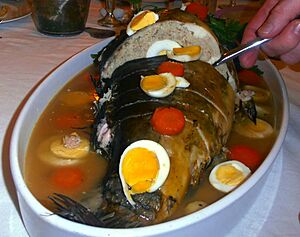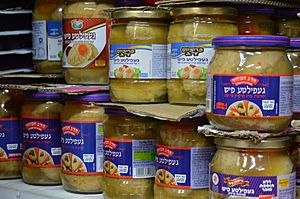Gefilte fish facts for kids

Gefilte fish topped with slices of carrot
|
|
| Course | Hors d'oeuvre |
|---|---|
| Region or state | Central and Eastern Europe, United States, Israel. |
| Created by | Ashkenazi Jewish communities |
| Main ingredients | Ground fish |
| This article contains IPA phonetic symbols. Without the correct software, you may see question marks, boxes, or other symbols instead of Unicode characters. |
Gefilte fish (/ɡəˈfɪltə fɪʃ/) is a special dish made from ground-up fish, like carp or pike. The name comes from a Yiddish phrase meaning "stuffed fish."
This dish is often served as a starter, or hors d'oeuvre, by Ashkenazi Jewish families. It's especially popular during Shabbat and Jewish holidays such as Passover, but people enjoy it all year round.
Long ago, gefilte fish was made by stuffing seasoned, minced fish back into the whole fish's skin. Over time, cooks found it easier to just make the seasoned fish into patties or fish balls, which is how it's often seen today. In Poland, this dish is called karp po żydowsku, meaning "carp Jewish-style."
Contents
Where Did Gefilte Fish Come From?
Gefilte fish likely began in German cooking. The oldest mention of "stuffed pike" (gefuelten hechden) is from a German cookbook called Daz Buoch von Guoter Spise, written around 1350 C.E. This dish was made from poached and mashed pike, flavored with herbs, then stuffed back into the fish skin and roasted.
This stuffed fish was popular with German Catholics during Lent, a time when they were not allowed to eat meat. By the Middle Ages, stuffed fish became a part of the food traditions of German and Eastern European Jews.
How Is Gefilte Fish Made and Served?
Gefilte fish was traditionally cooked inside the whole fish's skin, forming a loaf. This loaf was then sliced before serving. Today, it's more commonly cooked and served as egg-shaped patties, similar to quenelles. In the United Kingdom, gefilte fish is often fried.
Gefilte fish is usually decorated with a slice of carrot on top. It's also often served with a spicy horseradish sauce called chrain.
To make the modern fish balls, fish fillets are ground up and mixed with eggs (though some recipes don't use eggs), breadcrumbs or matza crumbs, spices, salt, onions, carrots, and sometimes potatoes. This mixture forms a paste or dough, which is then gently cooked in fish broth.
Common fish used for gefilte fish include Carp, pike, mullet, or whitefish. More recently, Nile perch and salmon are also used. Gefilte fish made from salmon has a slightly pink color. However, Catfish is not used because it is not kosher (meaning it doesn't follow Jewish dietary laws).
Sweet or Savory?
Gefilte fish can be either a little sweet or savory. Whether it's made with sugar or black pepper often shows if a Jewish community was from Galitzianer (who preferred sugar) or Litvak (who preferred pepper) regions. This difference in taste even led to a saying: the line separating northern from southern East Yiddish was called "the Gefilte Fish Line." This means that where you lived in Eastern Europe could tell you how your gefilte fish tasted!
In the 1800s, sweeter gefilte fish became more common in the western part of this divide. This happened because the sugar beet industry grew in Poland, making sugar more available.
Ready-to-Serve Gefilte Fish
In the late 1930s, companies started selling ready-to-eat gefilte fish in jars. Brands like Mother's, Manischewitz, Mrs. Adler’s, and Rokeach became popular.
After World War II, commercial gefilte fish was often sold as patties or balls. Sometimes, it was made into a "log" of ground fish, wrapped in wax paper, and then poached or baked. This product is sold in cans and glass jars, packed in a jelly made from fish broth, or in the broth itself.
Gefilte fish has been called "an acquired taste," meaning some people need time to get used to its flavor. Grocery stores also sell frozen "logs" of gefilte fish that you can cook at home.
Religious Customs
Jewish Traditions
For many religious Jews, gefilte fish is a traditional Shabbat food. This is because it helps avoid borer, which is one of the 39 activities prohibited on Shabbat. Borer means "selection" or "choosing," and it refers to picking bones out of fish, which is not allowed on Shabbat. Since gefilte fish is already deboned, it makes eating fish on Shabbat easier.
Some people also believe that fish are protected from the ayin hara (meaning "evil eye" or bad luck) because they live underwater. So, a dish made from several types of fish is thought to bring good luck.
The Hebrew word for fish, Dag, has a numerical value of seven, which is the number of the Sabbath day. This further highlights why fish is often eaten on Shabbat. Since Jewish law forbids separating fish flesh from its bones on Shabbat, pre-made fish cakes like gefilte fish are a perfect solution, making them a regular part of the Shabbat meal.
Catholic Traditions
In Polish Catholic homes, especially in northern regions near the Baltic Sea, gefilte fish (called Polish: karp po żydowsku) is a traditional dish eaten on Christmas Eve and Holy Saturday. These are traditionally meatless feast days. This shows how some Jewish non-meat dishes also became popular for Catholic religious days in Poland.
Images for kids
See also
 In Spanish: Gefilte fish para niños
In Spanish: Gefilte fish para niños




